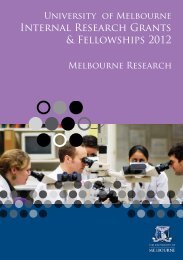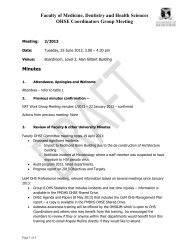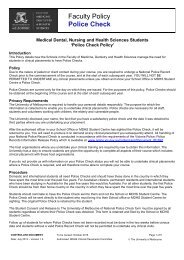A Body of Evidence: An Art Historical perspective on Eighteenth and ...
A Body of Evidence: An Art Historical perspective on Eighteenth and ...
A Body of Evidence: An Art Historical perspective on Eighteenth and ...
Create successful ePaper yourself
Turn your PDF publications into a flip-book with our unique Google optimized e-Paper software.
that its flesh is the l<strong>and</strong>, its b<strong>on</strong>es are the structure <str<strong>on</strong>g>of</str<strong>on</strong>g> the rocks … its blood is the<br />
pools <str<strong>on</strong>g>of</str<strong>on</strong>g> water … its breathing <strong>and</strong> its pulse are the ebb <strong>and</strong> flow <str<strong>on</strong>g>of</str<strong>on</strong>g> the sea.“ 65<br />
As already remarked, the definiti<strong>on</strong> <str<strong>on</strong>g>of</str<strong>on</strong>g> man as a part <str<strong>on</strong>g>of</str<strong>on</strong>g> the order <str<strong>on</strong>g>of</str<strong>on</strong>g> the world was encompassed<br />
within the Renaissance belief that the macrocosm <str<strong>on</strong>g>of</str<strong>on</strong>g> the universe was reflected in every<br />
microcosm, including the order <str<strong>on</strong>g>of</str<strong>on</strong>g> the body. 66 It seems that there was a corresp<strong>on</strong>ding reflecti<strong>on</strong><br />
back into the definiti<strong>on</strong> <str<strong>on</strong>g>of</str<strong>on</strong>g> nature as man’s awareness <str<strong>on</strong>g>of</str<strong>on</strong>g> the c<strong>on</strong>structi<strong>on</strong> <strong>and</strong> functi<strong>on</strong> <str<strong>on</strong>g>of</str<strong>on</strong>g> the body<br />
advanced. Therefore, as dem<strong>on</strong>strated by Le<strong>on</strong>ardo’s quotati<strong>on</strong>, the surrounding world was<br />
defined in the new terms <str<strong>on</strong>g>of</str<strong>on</strong>g> the human anatomy.<br />
Beginning with Vesalius, illustrati<strong>on</strong> <str<strong>on</strong>g>of</str<strong>on</strong>g> anatomy in both models <strong>and</strong> drawings<br />
was <strong>on</strong>e not <str<strong>on</strong>g>of</str<strong>on</strong>g> cadavers <strong>and</strong> dissecti<strong>on</strong> but rather a living form <str<strong>on</strong>g>of</str<strong>on</strong>g> skelet<strong>on</strong>s <strong>and</strong><br />
eviscerated bodies. This visi<strong>on</strong> <str<strong>on</strong>g>of</str<strong>on</strong>g> apparently ‘walking dead’ had a tw<str<strong>on</strong>g>of</str<strong>on</strong>g>old<br />
purpose. First it was a method <str<strong>on</strong>g>of</str<strong>on</strong>g> distancing anatomy <strong>and</strong> the workings <str<strong>on</strong>g>of</str<strong>on</strong>g> the<br />
living body from the indelicate nature <str<strong>on</strong>g>of</str<strong>on</strong>g> dissecti<strong>on</strong> <strong>and</strong> the associated gruesome<br />
procurement <str<strong>on</strong>g>of</str<strong>on</strong>g> bodies. Sec<strong>on</strong>d, this form <str<strong>on</strong>g>of</str<strong>on</strong>g> representati<strong>on</strong> emphasised that<br />
anatomy was a study not <str<strong>on</strong>g>of</str<strong>on</strong>g> pathology but rather <str<strong>on</strong>g>of</str<strong>on</strong>g> the living interior <str<strong>on</strong>g>of</str<strong>on</strong>g> the<br />
human body. Barbara Stafford argues that there was a clear distincti<strong>on</strong> between<br />
the cerebral functi<strong>on</strong> <str<strong>on</strong>g>of</str<strong>on</strong>g> explaining the internal workings <str<strong>on</strong>g>of</str<strong>on</strong>g> the human body, <strong>and</strong><br />
the physical or corporeal reality <str<strong>on</strong>g>of</str<strong>on</strong>g> cutting <strong>and</strong> dissecting cadavers. 67 The move<br />
away from the reality <str<strong>on</strong>g>of</str<strong>on</strong>g> dissecti<strong>on</strong> was dem<strong>on</strong>strated within the representati<strong>on</strong><br />
<str<strong>on</strong>g>of</str<strong>on</strong>g> anatomy in texts <strong>and</strong> models.<br />
65 Quoted in Burke, p. 208.<br />
66 Kemp, 1981, p. 114.<br />
67 Stafford, 1991, p. 47.












